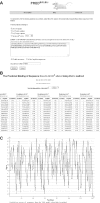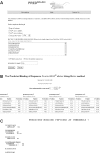PREDBALB/c: a system for the prediction of peptide binding to H2d molecules, a haplotype of the BALB/c mouse
- PMID: 15980450
- PMCID: PMC1160239
- DOI: 10.1093/nar/gki479
PREDBALB/c: a system for the prediction of peptide binding to H2d molecules, a haplotype of the BALB/c mouse
Abstract
PRED(BALB/c) is a computational system that predicts peptides binding to the major histocompatibility complex-2 (H2(d)) of the BALB/c mouse, an important laboratory model organism. The predictions include the complete set of H2(d) class I (H2-K(d), H2-L(d) and H2-D(d)) and class II (I-E(d) and I-A(d)) molecules. The prediction system utilizes quantitative matrices, which were rigorously validated using experimentally determined binders and non-binders and also by in vivo studies using viral proteins. The prediction performance of PRED(BALB/c) is of very high accuracy. To our knowledge, this is the first online server for the prediction of peptides binding to a complete set of major histocompatibility complex molecules in a model organism (H2(d) haplotype). PRED(BALB/c) is available at http://antigen.i2r.a-star.edu.sg/predBalbc/.
Figures


Similar articles
-
Toward the prediction of class I and II mouse major histocompatibility complex-peptide-binding affinity: in silico bioinformatic step-by-step guide using quantitative structure-activity relationships.Methods Mol Biol. 2007;409:227-45. doi: 10.1007/978-1-60327-118-9_16. Methods Mol Biol. 2007. PMID: 18450004
-
MULTIPRED: a computational system for prediction of promiscuous HLA binding peptides.Nucleic Acids Res. 2005 Jul 1;33(Web Server issue):W172-9. doi: 10.1093/nar/gki452. Nucleic Acids Res. 2005. PMID: 15980449 Free PMC article.
-
PREDNOD, a prediction server for peptide binding to the H-2g7 haplotype of the non-obese diabetic mouse.Autoimmunity. 2006 Dec;39(8):645-50. doi: 10.1080/08916930601062494. Autoimmunity. 2006. PMID: 17178561
-
An in silico immunological approach for prediction of CD8+ T cell epitopes of Leishmania major proteins in susceptible BALB/c and resistant C57BL/6 murine models of infection.Infect Genet Evol. 2009 May;9(3):344-50. doi: 10.1016/j.meegid.2008.02.011. Epub 2008 Mar 4. Infect Genet Evol. 2009. PMID: 18420466
-
On naming H2 haplotypes: functional significance of MHC class Ib alleles.Immunogenetics. 1997;46(1):53-62. doi: 10.1007/s002510050242. Immunogenetics. 1997. PMID: 9148789 Review.
Cited by
-
Immunoprophylaxis of multi-antigen peptide (MAP) vaccine for human lymphatic filariasis.Immunol Res. 2017 Jun;65(3):729-738. doi: 10.1007/s12026-017-8911-5. Immunol Res. 2017. PMID: 28432603
-
Involvement of CD8+ T cell-mediated immune responses in LcrV DNA vaccine induced protection against lethal Yersinia pestis challenge.Vaccine. 2011 Sep 9;29(39):6802-9. doi: 10.1016/j.vaccine.2010.12.062. Epub 2011 Jan 1. Vaccine. 2011. PMID: 21199697 Free PMC article.
-
SARS coronavirus nucleocapsid immunodominant T-cell epitope cluster is common to both exogenous recombinant and endogenous DNA-encoded immunogens.Virology. 2006 Mar 30;347(1):127-39. doi: 10.1016/j.virol.2005.11.042. Epub 2006 Jan 4. Virology. 2006. PMID: 16387339 Free PMC article.
-
A DNA vaccine encoding multiple HIV CD4 epitopes elicits vigorous polyfunctional, long-lived CD4+ and CD8+ T cell responses.PLoS One. 2011 Feb 11;6(2):e16921. doi: 10.1371/journal.pone.0016921. PLoS One. 2011. PMID: 21347287 Free PMC article.
-
Vaccine Design and Vaccination Strategies against Rickettsiae.Vaccines (Basel). 2021 Aug 12;9(8):896. doi: 10.3390/vaccines9080896. Vaccines (Basel). 2021. PMID: 34452021 Free PMC article. Review.
References
-
- Pamer E., Cresswell P. Mechanisms of MHC class I–restricted antigen processing. Annu. Rev. Immunol. 1998;16:323–358. - PubMed
-
- Villadangos J.A., Bryant R.A., Deussing J., Driessen C. Proteases involved in MHC class II antigen presentation. Immunol. Rev. 1999;172:109–120. - PubMed
-
- Yewdell J.W., Bennink J.R. Cut and trim: generating MHC class I peptide ligands. Curr. Opin. Immunol. 2001;13:13–18. - PubMed
-
- Bryant P., Ploegh H. Class II MHC peptide loading by the professionals. Curr. Opin. Immunol. 2004;16:96–102. - PubMed
-
- Zhong W., Reche P.A., Lai C.C., Reinhold B., Reinherz E.L. Genome-wide characterization of a viral cytotoxic T lymphocyte epitope repertoire. J. Biol. Chem. 2003;278:45135–45144. - PubMed
Publication types
MeSH terms
Substances
Grants and funding
LinkOut - more resources
Full Text Sources
Other Literature Sources

